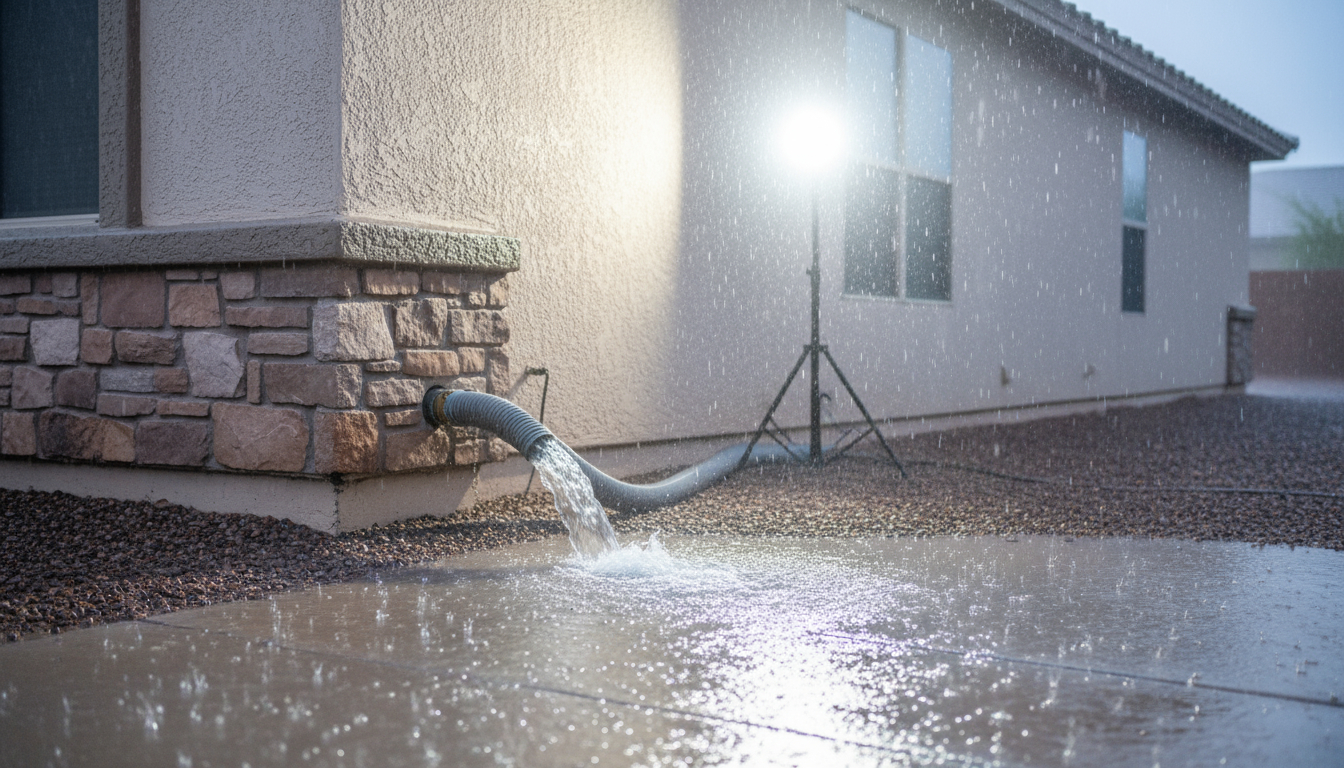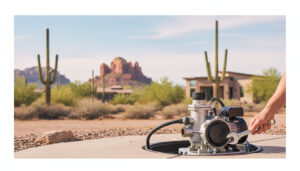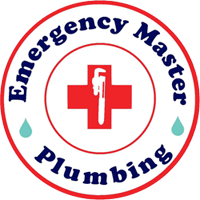

Sump pumps are essential for preventing water damage in Arizona homes, especially during monsoon season when flash floods can overwhelm basements and crawl spaces. By following proper maintenance tips tailored to Arizona’s unique climate, homeowners can ensure their sump pumps function reliably and avoid costly repairs.
Understanding Sump Pumps in Arizona’s Climate
Arizona’s desert environment might seem dry, but the state’s intense monsoon rains, which typically occur from June to September, can bring sudden downpours that lead to flooding in low-lying areas. Sump pumps play a critical role in managing this excess water by collecting it in a sump pit and pumping it away from the home’s foundation. Without a functioning sump pump, water can seep into basements, causing structural damage, mold growth, and even health hazards from contaminated water.
In cities like Phoenix, Tucson, and Scottsdale, where many homes are built on expansive soils that shift with moisture changes, a reliable sump pump is not just a convenience—it’s a necessity. According to the Arizona Department of Water Resources, flash floods account for a significant portion of property damage claims each year. Homeowners who neglect sump pump maintenance often face emergencies during storms, leading to thousands of dollars in repairs. This guide provides problem-solving strategies to help you maintain your sump pump effectively, drawing on expert insights from plumbing professionals with years of experience in Arizona’s challenging conditions.
Common Sump Pump Problems in Arizona Homes
Before diving into maintenance tips, it’s important to recognize the common issues that Arizona homeowners encounter with sump pumps. The state’s high temperatures and dust can exacerbate wear and tear on these systems.
One frequent problem is clogging from debris. Arizona’s dusty winds carry sand and dirt into sump pits, which can block the pump’s intake or float switch. This leads to the pump failing to activate during heavy rains, resulting in basement flooding. Another issue is power failures during monsoons, when storms often cause outages—without a battery backup, your sump pump becomes useless just when you need it most.

Overheating is also a concern in Arizona’s scorching summers, where temperatures can exceed 110°F. Pumps that run continuously or are exposed to heat may burn out prematurely. Additionally, the hard water prevalent in many Arizona regions causes mineral buildup, which can corrode pipes and reduce pump efficiency. Homeowners in areas like Mesa or Chandler, where groundwater is mineral-rich, report higher instances of this problem.
Corrosion from infrequent use is another Arizona-specific challenge. Since rainfall is sporadic, sump pumps might sit idle for months, allowing rust to form on metal components. If not addressed, this can lead to complete system failure during the next storm. Identifying these problems early through regular checks can save you from the stress of water damage and the expense of emergency plumbing services.
Essential Sump Pump Maintenance Tips
Maintaining your sump pump doesn’t require advanced skills, but it does demand consistency. Here are step-by-step, problem-solving tips to keep your system in top shape, tailored for Arizona’s climate.
Start with visual inspections every three months. Look inside the sump pit for accumulated debris like dirt, rocks, or leaves that Arizona’s winds might deposit. Remove any buildup using a wet/dry vacuum or by hand with gloves. This simple step prevents clogs that could cause the pump to fail during a monsoon. If you notice unusual odors, it might indicate bacterial growth—clean the pit with a mild bleach solution diluted in water to sanitize it without damaging components.
Test the pump’s operation quarterly. Pour a bucket of water into the sump pit until the float rises and activates the pump. Listen for smooth operation; grinding noises suggest impeller issues, often caused by sand abrasion in desert areas. If the pump doesn’t start, check the power cord and outlet—Arizona’s dust can cause connections to loosen over time. For battery backup systems, test the battery by unplugging the main power and ensuring the pump runs on auxiliary power. Replace batteries every two to three years to avoid failures during outages.
Clean the discharge line annually. In Arizona, where temperatures fluctuate wildly, frozen discharge lines aren’t common, but blockages from mineral deposits are. Disconnect the line and flush it with a garden hose to remove buildup. If you live in hard water areas like Gilbert or Tempe, consider installing a water softener to minimize scaling. This maintenance solves the problem of reduced water flow, ensuring the pump can expel water efficiently during heavy rains.
Lubricate moving parts as needed. Sump pumps have motors and floats that benefit from occasional lubrication, especially in dry climates where parts can seize. Use a manufacturer-recommended oil sparingly on the float rod and check for rust. For submersible pumps common in Arizona homes, ensure the unit is sealed properly to protect against dust ingress.
Schedule professional inspections yearly. While DIY maintenance covers basics, a licensed plumber can perform deeper checks, such as measuring voltage and amperage to detect electrical issues early. In Arizona, where extreme heat can degrade wiring, this is crucial for preventing fires or failures.
Advanced Maintenance for Long-Term Reliability
For homeowners seeking to go beyond basics, advanced strategies can enhance sump pump performance in Arizona’s harsh environment.
Install a high-water alarm system. These devices alert you via sound or app notification if water levels rise too high, giving you time to address issues before flooding occurs. In flood-prone areas like Flagstaff or parts of the Phoenix Valley, this technology has proven invaluable, reducing damage claims by allowing quick intervention.
Consider upgrading to a sump pump with smart features. Modern models integrate with home automation systems, sending alerts to your phone about potential failures. For Arizona residents, look for pumps rated for high temperatures and dust resistance, such as those with sealed motors.
Address foundation concerns proactively. Arizona’s soil expansion during monsoons can crack sump pits. Inspect for cracks and seal them with hydraulic cement to prevent leaks. If your home is in an area with high groundwater, like near the Salt River, consult a professional about sump pump capacity—upgrading to a higher horsepower model might be necessary.
Monitor for signs of wear unique to Arizona. Excessive vibration could indicate imbalance from sand erosion, while unusual humming might signal motor strain from heat. Replacing worn parts promptly solves these issues, extending the pump’s lifespan from the typical 10 years to potentially longer.
Preventing Costly Repairs and Water Damage
Regular maintenance isn’t just about functionality—it’s about cost savings. A failed sump pump during a monsoon can lead to water damage costing $5,000 or more in repairs, not including mold remediation. By following these tips, you mitigate risks and protect your investment.
Incorporate seasonal preparations. Before monsoon season, clear gutters and downspouts to direct water away from the foundation, reducing the sump pump’s workload. In winter, even though Arizona rarely freezes, insulate exposed pipes to prevent any rare cold snaps from causing issues.
Educate yourself on warranty details. Most sump pumps come with warranties that require proof of maintenance; keeping records of your inspections can help with claims if needed.
When to Call a Professional
While many maintenance tasks are DIY-friendly, certain situations demand expert help. If your sump pump is over 7 years old, runs continuously without rain, or shows signs of electrical issues, it’s time to consult a professional. In Arizona, where rapid weather changes can turn a small problem into an emergency, prompt action is key.
For residents in the Phoenix area, reliable service is essential. Emergency Master Plumbing & Air specializes in sump pump maintenance and repairs, ensuring your system is ready for Arizona’s unpredictable weather. With experienced technicians who understand local challenges, they offer comprehensive inspections and installations. Contact them at 623-584-4706 for personalized advice or to schedule a service.
By implementing these sump pump maintenance tips, Arizona homeowners can safeguard their properties against flooding and enjoy peace of mind year-round. Consistent care transforms potential problems into preventable issues, keeping your home dry and secure.
